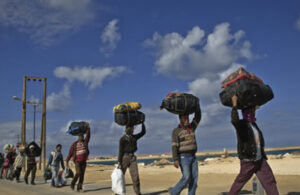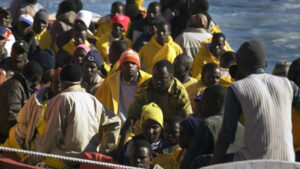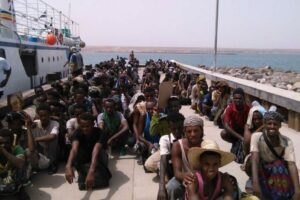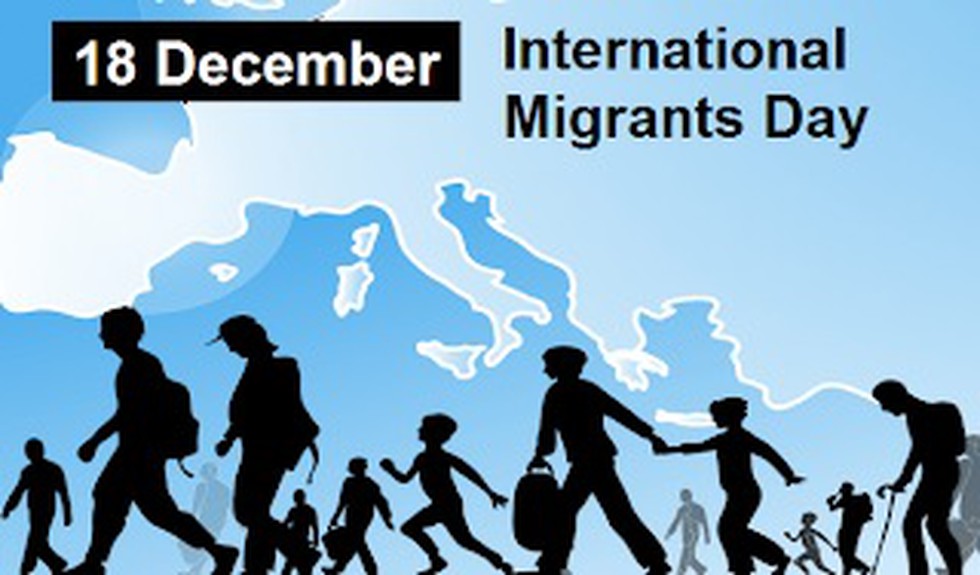December 18 every year, is recognised by the United Nations (UN) as International Migrants Day to remember and identify the challenges of migrant workers as well as their contributions to national development in terms of remittances to the families.
On December 4, 2000, the UN General Assembly (UNGA), taking into account the large and increasing number of migrants in the world, proclaimed December 18 as International Migrants Day.
The day was selected to mark the anniversary of the 1990 adoption by UNGA of the International Convention on the Protection of the Rights of All Migrant Workers and Members of Their Families. The day would be marked this year on Saturday, December 18, 2021 on the theme: Harnessing the Potential of Human Mobility.
International Migrants Day (18 December) this year falls almost exactly 70 years after the Brussels conference that lead to the establishment of the organization that, in 1989, was renamed the International Organization for Migration. A broad range of factors continue to determine the movement of people. They are either voluntary or forced movements as a result of the increased magnitude and frequency of disasters, economic challenges and extreme poverty or conflict. Approximately 281 million people were international migrants in 2020, representing 3.6 per cent of the global population.
All these will significantly affect the characteristics and scale of migration in the future, and determine the strategies and policies countries must develop in order to harness the potential of migration while ensuring the fundamental human rights of migrants are protected.
Migration, generally described as human mobility, is one of the world’s oldest phenomena especially as evidenced from Christian scripture. Abraham, our Father in Faith, became a Migrant when he accepted God’s call to leave his homeland to an unknown destination.
Mary and Joseph had to migrate in other to save the life of the Infant Jesus, our Saviour. In modern time, migration continue to happen at the global level which is largely driven by economic, political and social pressures; mainly as an escape from poverty, bad governance and conflicts.
In Ghana, both internal and external migration have been characterized by young people as seen in Kayayee (Female Porters) in the cities and those recently rescued from ill-treatment in Libya. Migration has enormous opportunities, especially if well managed. We are fully aware of the challenges and problems associated with irregular migration in our world today.

With migration becoming a major issue of contention and debate in modern society, Ghana as sovereign nation and Africa, in general has a duty to look into the activities of individuals, groups and organisations involved in open recruitment, orientation and facilitation of the youth for irregular migration, which has become crime against humanity.
Migrants in general in spite of some challenging factors, contribute with their knowledge, networks, and skills to build stronger, more resilient communities. The global social and economic landscape can be shaped through impactful decisions to address the challenges and opportunities presented by global mobility and people on the move.
The International Organization for Migration (IOM) has assisted millions of migrants since it emerged 70 years ago to assist the vast number of Europeans displaced by the Second World War and continues to lead the way in promoting a humane and orderly management of migration for the benefit of all, including the communities of origin, transit and destination.
Situation of Migration in Ghana
Possibly, the situation of migration in Ghana manifests all the types of human movements. Young people are risking their lives through the desert, Mediterranean Sea or through stowaway to leave Ghana for perceived well-being and better conditions in Europe.
This has been well documented and well known to all. However, professionals like Medical doctors and Nurses are also leaving Ghana for Europe or other well-endowed economies in Africa like South Africa and Botswana. They become Immigrants, legal or illegal, in their destinations or transit points.
Between 2013 and 2016, the number of Ghanaians who travelled by sea to Italy alone grew exponentially from about 1,000 to about 5,000 each year. I am of the view that it is not the poor who take the risk of migrating through the Sahara but those who are able to put together some money which otherwise could have been used to start a petty business here in Ghana. These irregular migrants indeed go through the very dangerous journey through the Sahara with most of them losing their lives.
Women especially arrive at their destination pregnant without knowing who the father of their babies are because they are raped on the journey by several men. According to information collected by the Ghana Immigration Service, more than 2000 Ghanaians women departed for work in the Middle East between September 2014 and January 2015.
Since then about 350 women have returned, reporting exploitation and abuse. The plights of these women in my opinion can be largely blamed on fraudulent advertisements for jobs opportunities in various countries including the Middle East.
Reportedly, over 20,000 refugees are currently in Ghana from Togo, Liberia, Sierra Leone, Cote d Ivoire, Mali and Niger. There are four settled refugee camps while some from Togo and Liberia have now been integrated into the local community due to cessation arrangements.
For Rural-Urban and North-South Migration, the biggest push factor is poverty and lack of alternative opportunities, especially for young people. This movement also include children who are used as head- potters, popularly referred to as ‘Kayayee’, in the cities. There are limited cases of urban-rural drifts mainly for illegal mining activities, also called ‘Galamsey’.
While some of the children leave voluntarily from Northern Ghana to the South, others are actually trafficked there or even beyond Ghana. Even those who move voluntarily to the cities in the South of Ghana, they too later fall into the trap of being trafficked due to hardships they encounter at their planned intended destination.
Seasonal movements of herdsmen from Mali, Niger and Chad into Northern Ghana is another issue that have created situations of over-grazing, destruction of farms and crops and occasional skirmishes between them and native inhabitants.
Currently, the movement is towards the south-wards due to reduction of grass cover/fodder in Northern Ghana. The implications of this kind of movement are now regularly being reported in some areas in Ashanti, former Brong-Ahafo (Now Bono, Bone East and Ahafo), Volta and Eastern Regions, all to the south of Ghana.
Harrowing Experiences of Two Ghanaian Immigrants
Sharing their traumatic experiences of irregular migration to Libya with this writer in 2019, two former Ghanaian immigrants who hailed from Nkoranza in the Bono east Region advised Ghanaian youth not to venture into migrating for greener pastures.
The Bono, Ahafo and the Bono East Regions formerly Brong-Ahafo Region especially in Techiman, Nkoranza, Kintampo and Atebubu have become a known area for unpleasant record for irregular migration among the youth. Records from the Ghana Immigration Service indicate that 4,092 have been repatriated from Libya in 2017. Out of this number, 1,562 were from the then Brong-Ahafo Region. Techiman and Nkoranza in particular, have become notorious for open recruitment, orientation and facilitation of many youths for irregular migration.
Narrating their ordeal in Accra to this writer, they said, “We borrow GHc2, 000 from people to embark on a journey to Libya with the intension of seeking greener pastures but we later realised that the journey is not all that rosy as we hear from those who have been there before.”
They said “Migrants going to Libya from Ghana start the journey from Nkoranza in the Bono East Region to Bawku through to Burkina Faso, Niamey and finally to Aggadey, a town in Niger where we are gathered in a pick-up vehicle for a two week journey in the desert to Tripoli, Libya.”

Sharing their harrowing experiences they said “If you are a young guy living at Nkoranza, a town in the Bono East Region of the Techiman Diocese and you do not have the great desire to embark on a journey to Libya for greener pastures then you will not be regarded as a man or a young man who do not know life.”
“On our journey, we experience a lot of challenges specially when we are run out of water or if the vehicle conveying us from Aggadey is short of water to run the engine, the little we have is used for the car and when that gets finish, we have to spend one week on the desert waiting for water to run the car,” they said. According to them, “we have to depend on urine to quench our thirst while some collapse due to the harrowing experience but after a week with God’s providence they get water through rains at far distances to enable as continue our journey.”
“Those who go to Libya and come back safely home do not tell the young people about the bad experience encountered on the journey but they only narrate the good side of being in Libya that is making money and becoming back home to spend,” the young former immigrants narrated to the saddened audience made up of Priests, Religious, Seminarians and lay faithful. Our motivation to travel, they added hence was that “friends go and come back to build and live good lives.”
“Migration is not a spectacular thing we will encourage because of the bad experience on the desert where some die on the way. “We have been through that ordeal and by the grace of God we are alive and reintegrated with our families and enjoying the little we gained from Libya,” they narrated.
Explaining the exact job immigrants do in Libya, they said, “Ghanaians are mainly maisons who only plaster buildings but we do without a working permit because we do not have documents and there are no opportunities to make papers in Libya.” “Where we work is the same place we sleep without doors and, windows,” they said, adding that at times with these disturbing experiences, you cannot return because our families in Ghana will see us as lazy people.”
They also explained “few Ghanaian women who brave themselves to travel also go through similar ordeal and when they manage to get to Libya, the only available work for them is prostitution.”
Reports from the International Organization of Migration and the missing Migrants Project indicate that in 2015, 3,262 migrants died along the central Mediterranean route alone. In 2018, another 2,229 migrants drowned along the same route. In 2019, the number stands at 953, a decline that may not necessarily be a sign of progress but for the deterrence of brutality.
With these statistics, there is greater need for the public to be more empathetic towards Migrants and Refugees in all their conditions; departing, returning, transit and settlement at their destination.
Media Campaign and Education
The media in Ghana has a duty to help in campaigning against Irregular Migration by taking key interest in addressing the situation in the country and educate Ghanaians, especially the youth on the risks involved in irregular migration.
There is the urgent need to educate the Ghanaian citizenry to discern more about migration since what people think about migration does not reflect the reality.
In my view, the independence of the media places a great responsibility on them to accurately inform the people on exactly what irregular migration is about in the risks involved in embarking on such a journey.
The media therefore needs to brace-up to educate people especially the teeming unemployed youth on fake news about greener pastures abroad which are sometimes very enticing luring them to embark on such journeys as narrated above in the experiences shared by two former Immigrants.
It is important for people to make informed decisions because most Ghanaians are ignorant of the reality on the ground. Research indicates that the about 70 percent of Ghanaians would emigrate if given the chance, with 42 percent intending to leave the country within the next five years. It was important therefore for the media to enlighten Ghanaians on all of these dangers to enable them make informed decisions as regards migration.
Conclusion
As the Holy Father, Pope Francis has considered the work on migration as a priority that he has taken a direct and personal responsibility for this ‘UNIT’ under the Dicastery for Promoting Human Development, it is hope that the Pope’s call on Governments, Intergovernmental Bodies, and indeed the Church would work towards “Welcoming, Protecting, Promoting and Integrating” migrants and Refugees.
Indeed, the plight of the Holy Family calls to mind the sufferings of the many men, women and children escaping war and persecution.
The holy season of Christmas, which we are about to celebrate is an invitation to come together to help those in need, especially young migrants who “instead of sitting in school desks, like many of their peers, spend their days doing long marches on foot, or on makeshift and dangerous means of transportation.”
As the Holy Father Pope Francis intimated sometime back that educating young migrants would give them the tools to find “work in the future and participate in the common good as informed citizens, it is the hope of this writer that at the same time, there is the need to educate ourselves in order to welcome and show solidarity so that migrants and refugees do not meet indifference or, worse, intolerance on their journey.

I commend the government of Ghana for coming out with a clear policy on migration and Human Trafficking, however, it needs to focus on its implementation and share this good initiative with other countries in Africa, so that the continent can collectively address the menace of irregular migration which is decimating the lives of many young people in Africa.
While encouraging Government to endeavour to implement the National Migration Policy, there is also the need to support the Regional and International efforts towards addressing the issue of migration with a comprehensive Global Compact which is yet to be adopted.
Strong caution also must go to individuals, groups and organisations involved in open recruitment, orientation and facilitation of the youth for irregular migration to stop this crime against humanity.



